[Emulate] TLM API 1.0 in SystemC
TLM API 1.0 in SystemC1
Introduction
What Dose TLM API 1.0 Provide and not?
- What does TLM API 1.0 provide?
- Define core interfaces and standard channels for communication
- Users can design their own channels implementing core interfaces
- Define core interfaces and standard channels for communication
- What is not defined in TLM API 1.0?
- The content of the transactions
- The task left for the TLM 2.0 that is now under development
- The constraints on the implementation of channels
- The content of the transactions
High Level Goals
- Provide a common way of TLM modeling at different levels
- A "recipe" that allows new users to get started quickly
- Help users avoid problems
- Concurrency, memory leaks, pointer aliasing, SEGFAULTS, etc.
- Achieve efficiency in space and time without sacrificing clarity and safety
- A set of interfaces that map to both HW and SW, and across HW/SW
- Create interfaces and methods that support IP reuse
- within a project from one abstraction level to another
- across projects
- Promote IP interoperability through standard interfaces
- Promote a design style encapsulating functions in a polymorphous way
- Operations on classes are independent of the class
- An arbiter that is independent of the transaction data type
General Strategy
- Establish a fundamental set of TLM interfaces
- Core interfaces
- Unidirectional interfaces - send data in one direction
tlm_put_if<T>,tlm_get_if<T>,tlm_peek_if<T>
- Bidirectional interfaces - send data in both directions
tlm_transport_if<REQ, RSP>tlm_maser_if<REQ, RSP>,tlm_slave_if<REQ, RSP>
- Unidirectional interfaces - send data in one direction
- Standard channels
tlm_fifo<T>,tlm_req_rsp_channel<REQ,RSP>tlm_transport_channel<REQ,RSP>
Communication Types
- Bidirectional communication
- A read transaction across a bus is bidirectional
- Burst write with a completion bus status is bidirectional
- Unidirectional communication
- Place read address on bus is unidirectional
- Send IP packet is unidirectional
- Complex protocol can be broken down into a sequence of bidirectional or unidirectional transfers
- A complex bus with address, control and data phases may look like a simple bidirectional read/write bus at a high level of abstraction, but more like a sequence of pipelined unidirectional transfers at a more detailed level
Interface Styles
- Similar to interfaces of
sc_fifo - Data transfer is effectively done by Pass-by-Value mechanism
- Use “const &” for interface parameters
- Data send back to caller as return value
- Never use pointer
- Never use non const & for inbound data
- Inbound data is always passed by
(const &)bool nb_put(const &)
- Outbound data is returned by value
- There is data to return
T get()
- There may not be data to return
- Return the status and pass in a
(non-const &) bool nb_get(T&)
- Return the status and pass in a
- There is data to return
- Effectively Pass-by-Value data transfer
- Pros
- Eliminate problems of pointers and dynamic memory allocation
- Help eliminate problems of race conditions
- Help you reason about concurrent systems
- Enable use of C++ smart containers and handles
- Simple, clear lifetime and ownership of objects
- Cons
- Naïve passing of large objects may lead to performance problems
- E.g., passing larger vectors or arrays of data by value
- Naïve passing of large objects may lead to performance problems
- Pros
//blocking write of sc_fifo
// call by reference
template <class T>
inline void sc_fifo<T>::write( const T& val_ ) // call by reference
{
while( num_free() == 0 )
sc_core::wait( m_data_read_event );
m_num_written ++;
buf_write( val_ ); // call by reference
request_update();
}
// pass by value
template <class T>
inline bool sc_fifo<T>::buf_write( const T& val_ )
{
if( m_free == 0 ) { return false; }
m_buf[m_wi] = val_; // pass by value
m_wi = ( m_wi + 1 ) % m_size;
m_free --;
return true;
}
Core Interfaces
Introduction of Core Interfaces
- Developed based on
sc_fifointerface - Primary unidirectional interfaces
tlm_put_if<T>(blocking+non-blocking)tlm_get_if<T>(blocking+non-blocking)tlm_peek_if<T>(blocking+non-blocking)
- Primary bidirectional interface
tlm_transport_if<REQ, RSP> (blocking)
- Channel specific bidirectional interfaces
tlm_master_if<REQ, RSP>(blocking+non-blocking)tlm_slave_if<REQ, RSP>(blocking+non-blocking)- Useful for
tlm_req_rsp_channelandtlm_transport_channel
Key Terms
- Peek
- Peek reads most recent valid value
- Similar to read to a variable or signal
- Put/Get
- Put queues data and moves a transaction from initiator to target
- Get consumes data and moves a transaction from target to initiator
- Similar to write/read from a FIFO
- Master/Slave
- Master initiates activity by issuing a request
- Slave passively waits for requests and returns a response
- Blocking
- Mean method implementation might call
wait() - Methods may not return immediately
- Methods can be called only from
SC_THREADprocesses
- Mean method implementation might call
- Non-blocking
- Mean method implementation can never call
wait() - Methods return immediately with a bool indicating the success
- Methods can be called from
SC_METHODorSC_THREADprocesses
- Mean method implementation can never call
Hierarchy of Core Interfaces
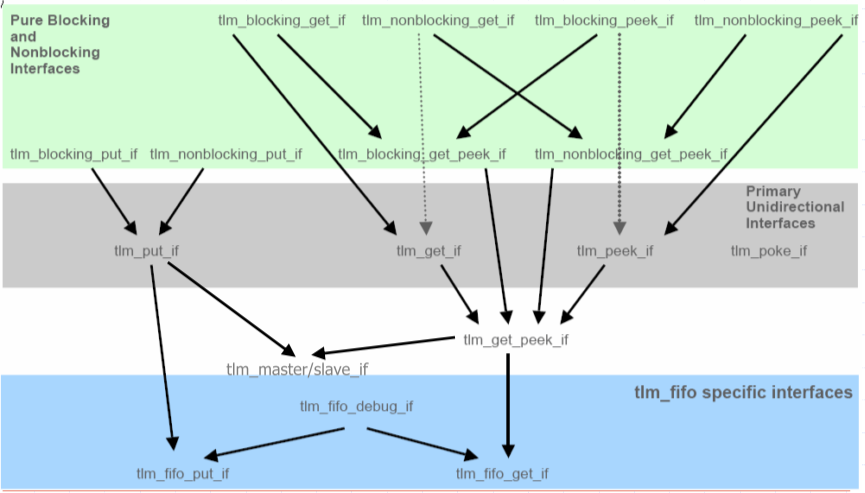
Unidirectional Interfaces
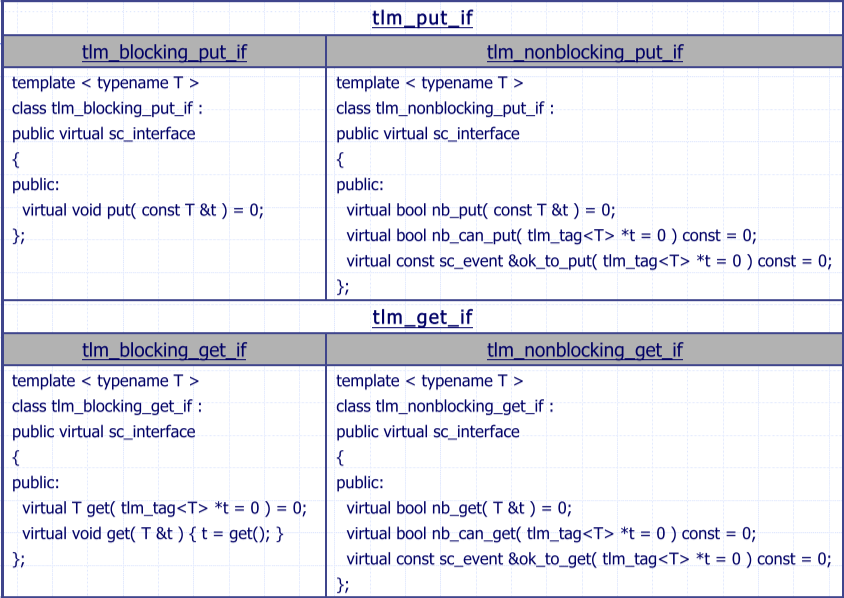

- Non-blocking interfaces may fail and thus must return a bool value
- Polling-based usage of non-blocking put, get, and peek
nb_can_put/get/peekenquires whether a transfer will be successful
- Interrupt-based usage of non-blocking put, get and peek
- Event functions enables an
SC_THREADto wait until it is likely that the access succeeds or aSC_METHODto be woken up
- Event functions enables an
Example of Bidirectional Interfaces
- Model transactions with a tight 1-to-1, non pipelined binding between the request and the response
- A merger between the blocking get and put functions
- Useful for modeling from a software programmer’s point of view
- A read with an address going in and the read data coming back
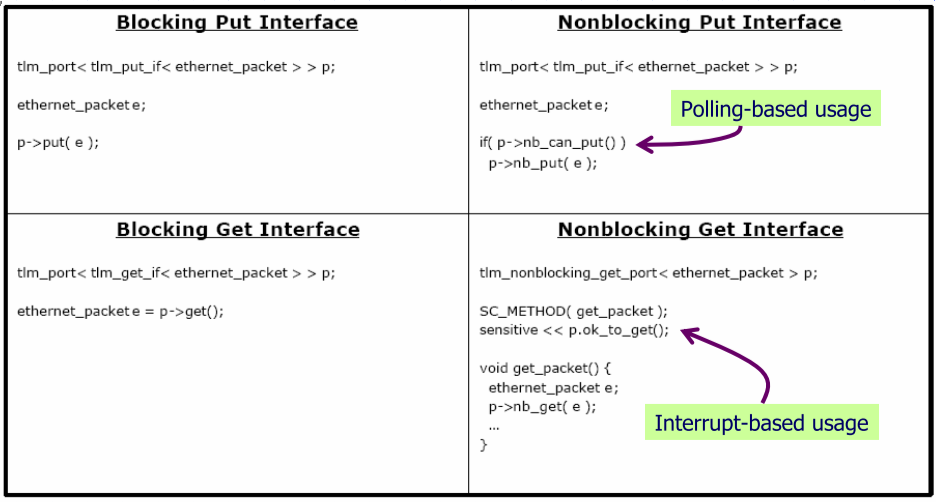
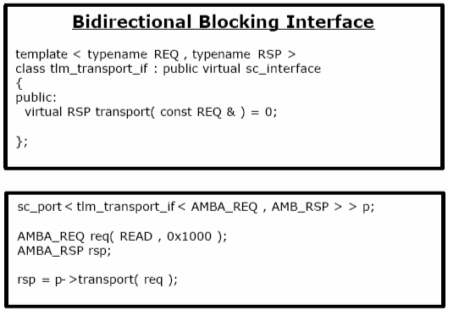

Hardware Implication
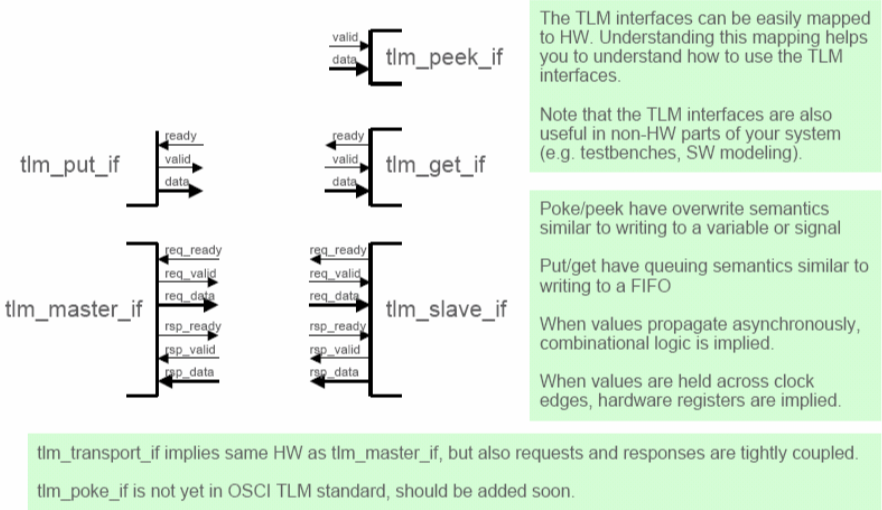
Standard Channels
Remarks
- Users can and should design their own channels implementing some or all of these core interfaces
- They can implement them directly in the target using
sc_export - The transport function in particular will often be directly implemented in a target when used to provide fast programmers view models for software prototyping
tlm_fifo<T>
- Implement all the unidirectional TLM interfaces based on
sc_fifo - Support request_update/update mechanism
- Support FIFO size of 0 and infinite
tlm_req_rsp_channel<REQ, RSP>
- One
tlm_fifofor the request going from initiator to target - One
tlm_fifofor the response being moved from target to initiator - The FIFOs in
tlm_req_rsp_channelcan be of arbitrary size
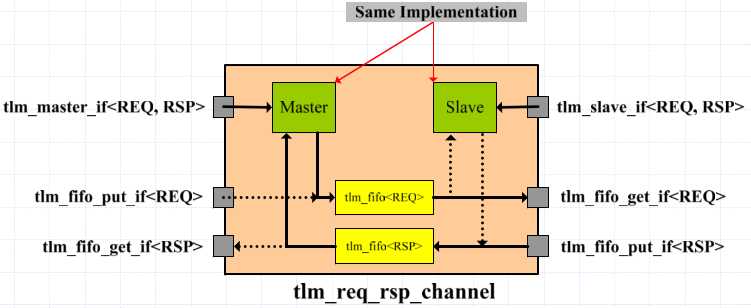
tlm_transport_channel
- 1-to-1, non pipelined binding between request and response
- The FIFOs in
tlm_req_rsp_channelmust be of size one - Used to bridge time and untimed TLMs
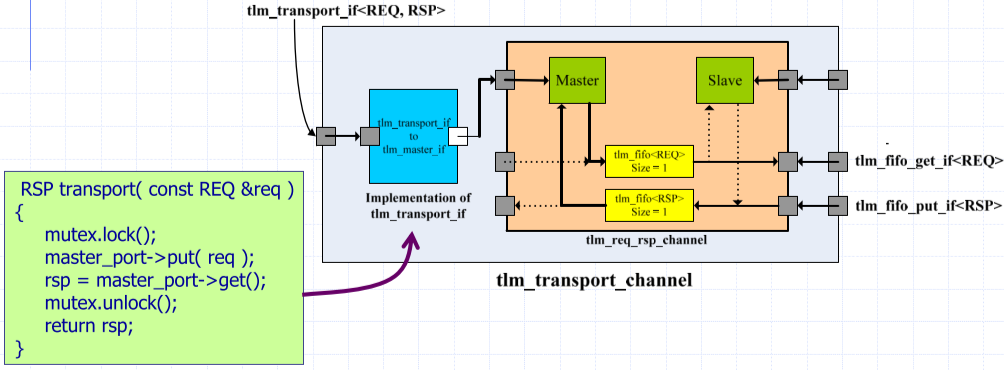
Background Information
Key Terms
- TLM target port
sc_exportbound to a TLM core interface
- TLM initiator port
sc_portbound to a TLM core interface- TLM target
- Module instantiating at least one TLM target port
- TLM initiator
- Module instantiating at least one TLM initiator port
- TLM transactions
- Data structures transferred by TLM core interface
- System initiator
- Example: a CPU issuing read/write requests
- Master
- System target
- Example: a memory serving read/write requests
- Slaver
- System transactions
- Example: a read/write operation from a CPU to a memory
- Corollary
- A system initiator is always a TLM initiator
- A system component might be both initiator and target
- A SystemC module might be both a TLM initiator and target
- A system transaction might be built from a sequence of several TLM transactions
Compare of sc_export and sc_port
-
sc_port(output)- Declare interfaces required at a module boundary
sc_port<IF>of a module requires that interface from the outside
-
sc_export(input)- Declare interfaces provided at a module boundary
sc_export<IF>of a module provides that interface to the outside- Improve speed by reducing the number of threads

- Allow
sc_portsto connect to more than one implementation of the same interface in the same top level block
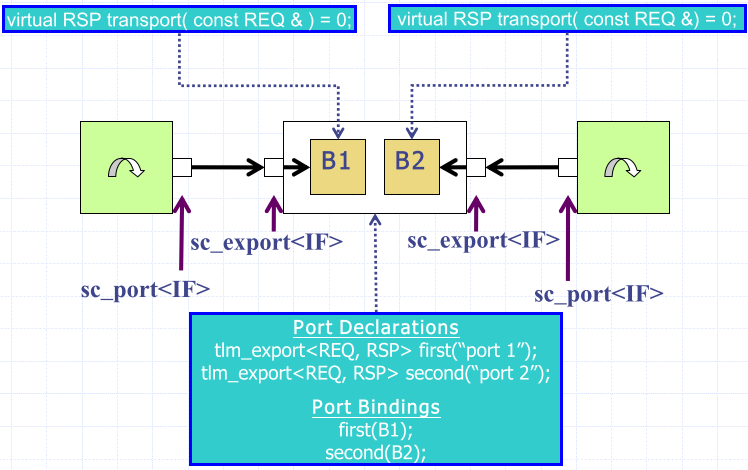
- Allow a different transport function for each protocol

- A thread in a low level sub module inside an initiator directly calls a method in low level sub module in a target
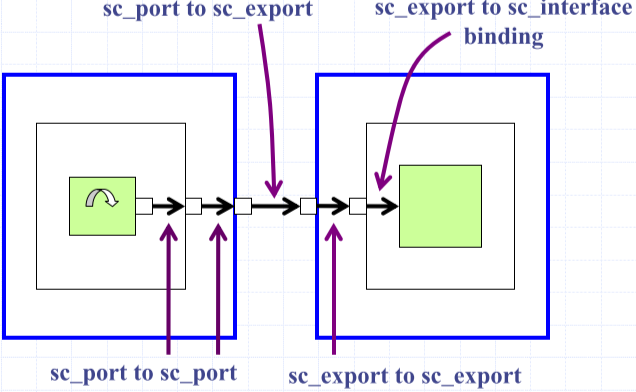
Improve Reusability
- Channels/
sc_exportoffering more than actually required bysc_portare still “Plug Compatible” [Lecture pp18-19] - C++ implicit conversions to base classes
- Having a hierarchy of interfaces is the key to enable this feature
- Require the most minimal interfaces for a given situation
- Use
sc_port<tlm_nonblocking_get_if<T> >rather thansc_port<tlm_get_if<T> > - Provide the maximal interfaces for a given situation
- Use
sc_export<tlm_get_if<T> >rather thansc_export<tlm_blocking_get_if<T> >
-
IOC5080(5940) System Model Design and Verification, Department of Computer Science, National Chiao-Tung University ↩